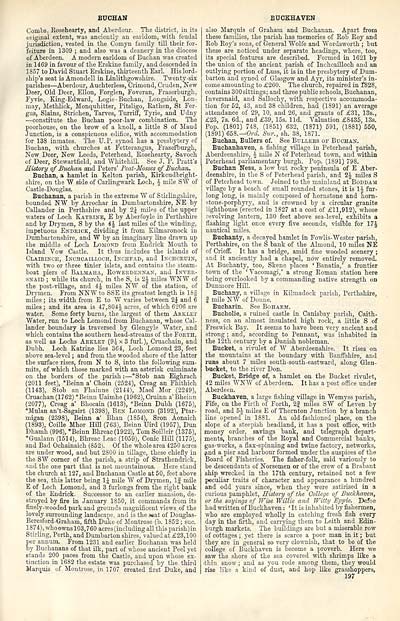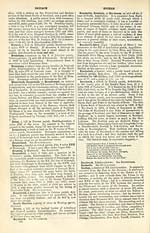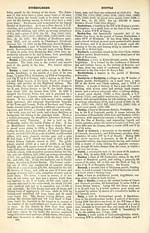Ordnance gazetteer of Scotland
(205) Page 197
Download files
Complete book:
Individual page:
Thumbnail gallery: Grid view | List view

BUCHAN
Combs, Rosehearty, and Aberdour. The district, in its
original extent, was anciently an earldom, with feudal
jurisdiction, vested in the Conryn family till their for-
feiture in 1309 ; and also was a deanery in the diocese
of Aberdeen. A modern earldom of Buchan was created
in 1469 in favour of the Erskine family, and descended in
1 857 to David Stuart Erskine, thirteenth Earl. His lord-
ship's seat is Amondell in Linlithgowshire. Twenty-six
parishes — Aberdour, Auchterless, Crimond, Cruden, New
Deer, Old Deer, Ellon, Forglen, Foveran, Fraserburgh,
Fyvie, King- Edward, Logie - Buchan, Longside, Lon-
may, Methlick, Monquhitter, Pitsligo, Rathen, St Fer-
gus, Slains, Strichen, Tarves, Turriff, Tyrie, and TJdny
— constitute the Buchan poor-law combination. The
poorhouse, on the brow of a knoll, a little S of Maud
Junction, is a conspicuous edifice, with accommodation
for 138 inmates. The U.P. synod has a presbytery of
Buchan, with churches at Fetterangus, Fraserburgh,
New Deer, New Leeds, Peterhead, Rosehearty, Savoeh
of Deer, Stewartfield, and Whitehill. See J. P. Pratt's
History of Buchan and Peters' Peat-Mosses of Buchan.
Buchan, a hamlet in Eelton parish, Kirkcudbright-
shire, on the "W side of Carlingwark Loch, J mile SW of
Castle-Douglas.
Buchanan, a parish in the extreme W of Stirlingshire,
bounded NW by Arrochar in Dumbartonshire, NE by
Callander in Perthshire and by 2J miles of the upper-
waters of Loch Katrine, E by Aberfoyle in Perthshire
and by Drymen, S by the 4J last miles of the winding,
impetuous Ekdrick, dividing it from Kilmaronock in
Dumbartonshire, and W by an imaginary line drawn up
the middle of Loch Lomond from Endrick Mouth to
Island Vow Castle. It thus includes the islands of
Clairinch, Inchcailloch, Inchfad, and Inchckuin,
with two or three tinier islets, and contains the steam-
hoat piers of Balmaha, Rowerdennan, and Inver-
snaid ; while its church, in the S, is 1\ miles WNW of
the post-village, and 4J miles NW of the station, of
Drymen. From NNWto SSE its greatest length is 18|
miles ; its width from E to W varies between 1\ and 6
miles; and its area is 47,8044 acres, of which 6206 are
water. Some forty burns, the largest of them Akklet
"Water, run to Loch Lomond from Buchanan, whose Cal-
lander boundary is traversed by Glengyle Water, and
which contains the southern head-streams of the Forth,
as well as Lochs Arklet (9i x 3 furl.), Cruachain, and
Dubh. Loch Katrine lies 364, Loch Lomond 23, feet
above sea-level ; and from the wooded shore of the latter
the surface rises, from N to S, into the following sum-
mits, of which those marked with an asterisk culminate
on the borders of the parish : — *Stob nan Eighrach
(2011 feet), *Beinn a' Choin (2524), Creag an Fhithich
(1143), Stob an Fhainne (2144), Maol Mor (2249),
Cruachan (1762) *Beinn Uaimhe (1962), Cruinn a' Bkeinn
(2077), Creag a' Bhocain (1613), *Beinn Dubh (1675),
*Mulan an't-Sagairt (1398), Ben Lomond (3192), Ptar-
migan (2398), Beinn a' Bhan (1854), Sron Aonaich
(1893), Coille Mhor Hill (763), Beinn TJird (1957), Dun
Dhamh (996), *Beinn Bhreac (1922), Tom Soilleir (1375),
*Gualann (1514), Bhreac Leac (1059), Conic Hill (1175),
and Bad Ochainaich (852). Of the whole area 4250 acres
are under wood, and but 2800 in tillage, these chiefly in
the SW corner of the parish, a strip of Strathendriek,
and the one part that is not mountainous. Here stand
the church at 127, and Buchanan Castle at 50, feet above
the sea, this latter being \\ mile W of Drymen, If mile
E of Loch Lomond, and 3 furlongs from the right bank
of the Endrick. Successor to an earlier mansion, de-
stroyed by fire in January 1850, it commands from its
finely -wooded park and grounds magnificent views of the
lovely surrounding landscape, and is the seat of Douglas-
Beresford-Graharn, fifth Duke of Montrose (b. 1852 ; sue.
1874), whoownsl03,760 acres (including all this parish)in
Stirling, Perth, and Dumbarton shires, valued at £23,100
per annum. From 1231 and earlier Buchanan was held
by Buchanans of that ilk, part of whose ancient Peel yet
stands 200 paces from the Castle, and upon whose ex-
tinction in 1682 the estate was purchased by the third
Marquis of Montrose, in 1707 created first Duke, and
BUCKHAVEN
also Marquis of Graham and Buchanan. Apart from
these families, the parish has memories of Rob Roy and
Rob Roy's sons, of General Wolfe and Wordsworth ; but
these are noticed under separate headings, where, too,
its special features are described. Formed in 1621 by
the union of the ancient parish of Inchcailloch and an
outlying portion of Luss, it is in the presbytery of Dum-
barton and synod of Glasgow and Ayr, its minister's in-
come amounting to £260. The church, repaired in f828,
contains 300 sittings ; and three public schools, Buchanan,
Inversnaid, and Sallochy, with respective accommoda-
tion for 52, 43, and 38 children, had (1891) an average
attendance of 29, 10, and 26, and grants of £31, 13s.,
£23, 7s. 6d., and £39, 15s. lid. Valuation £8435, 13s.
Pop. (1801) 748, (1851) 632, (1871) 591, (1881) 550,
(1891) 658.— Orel. Sur., sh. 38, 1871.
Buchan, Bullers of. See Bullers of Buchan.
Buchanhaven, a fishing village in Peterhead parish,
Aberdeenshire, \ mile N of Peterhead town, and within
Peterhead parliamentary burgh. Pop. (1891) 798.
Buchan Ness, a low hut rocky peninsula of E Aber-
deenshire, in the S of Peterhead parish, and 2J miles S
of Peterhead town. Joined to the mainland at Boddam
village by a beach of small rounded stones, it is 1 J fur-
long long, is mainly composed of hornstone and horn-
stone-porphyry, and is crowned by a circular granite
lighthouse (erected in 1827 at a cost of £11,912), whose
revolving lantern, 130 feet above sea-level, exhibits a
flashing light once every five seconds, visible for 17J
nautical miles.
Buchanty, a decayed hamlet in Fowlis-Wester parish,
Perthshire, on the S bank of the Almond, 10 miles NE
of Crieff. It has a bridge, amid fine wooded scenery ;
and it anciently had a chapel, now entirely removed.
At Buchanty, too, Skene places ' Banatia,' a frontier
town of the ' Vacomagi,' a strong Roman station here
being overlooked by a commanding native strength on
Dunmore Hill.
Buchany, a village in Kilmadock parish, Perthshire,
J mile NW of Doune.
Bucharin. See Boharii.
Bucholie, a ruined castle in Canisbay parish, Caith-
ness, on an almost insulated high rock, a little S of
Freswick Bay. It seems to have been very ancient and
strong ; and, according to Pennant, was inhabited in
the 12th century by a Danish nobleman.
Bucket, a rivulet of W Aberdeenshire. It rises on
the mountains at the boundary with Banffshire, and
runs about 7 miles south-south-eastward, along Glen-
bucket, to the river Don.
Bucket, Bridge of, a hamlet on the Bucket rivulet,
42 miles WNW of Aberdeen. It has a post office under
Aberdeen.
Buckhaven, a large fishing village in Wemyss parish,
Fife, on the Firth of Forth, 2| miles SW of Leven by
road, and 5J miles E of Thornton Junction by a branch
line opened in 1881. An old-fashioned place, on the
slope of a steepish headland, it has a post office, with
money order, savings bank, and telegraph depart-
ments, branches of the Royal and Commercial banks,
gas-works, a flax-spinning and twine factory, networks,
and a pier and harbour formed under the auspices of the
Board of Fisheries. The fisher-folk, said variously to
be descendants of Norsemen or of the crew of a Brabant
ship wrecked in the 17th century, retained not a few
peculiar traits of character and appearance a hundred
and odd years since, when they were satirised in a
curious pamphlet, History of the College of Buckhaven,
or the sayings of Wise Willie and Witty Efflie. Defoe
had written of Buckhaven : ' It is inhabited by fishermen,
who are employed wholly in catching fresh fish every
day in the firth, and carrying them to Leith and Edin-
burgh markets. The buildings are but a miserable row
of cottages ; yet there is scarce a poor man in it ; but
they are in general so very clownish, that to be of the
college of Buckhaven is become a proverb. Here we
saw the shore of the sea covered with shrimps like a
■thin snow ; and as you rode among them, they would
rise like a kind of dust, and hop like grasshoppers,
197
Combs, Rosehearty, and Aberdour. The district, in its
original extent, was anciently an earldom, with feudal
jurisdiction, vested in the Conryn family till their for-
feiture in 1309 ; and also was a deanery in the diocese
of Aberdeen. A modern earldom of Buchan was created
in 1469 in favour of the Erskine family, and descended in
1 857 to David Stuart Erskine, thirteenth Earl. His lord-
ship's seat is Amondell in Linlithgowshire. Twenty-six
parishes — Aberdour, Auchterless, Crimond, Cruden, New
Deer, Old Deer, Ellon, Forglen, Foveran, Fraserburgh,
Fyvie, King- Edward, Logie - Buchan, Longside, Lon-
may, Methlick, Monquhitter, Pitsligo, Rathen, St Fer-
gus, Slains, Strichen, Tarves, Turriff, Tyrie, and TJdny
— constitute the Buchan poor-law combination. The
poorhouse, on the brow of a knoll, a little S of Maud
Junction, is a conspicuous edifice, with accommodation
for 138 inmates. The U.P. synod has a presbytery of
Buchan, with churches at Fetterangus, Fraserburgh,
New Deer, New Leeds, Peterhead, Rosehearty, Savoeh
of Deer, Stewartfield, and Whitehill. See J. P. Pratt's
History of Buchan and Peters' Peat-Mosses of Buchan.
Buchan, a hamlet in Eelton parish, Kirkcudbright-
shire, on the "W side of Carlingwark Loch, J mile SW of
Castle-Douglas.
Buchanan, a parish in the extreme W of Stirlingshire,
bounded NW by Arrochar in Dumbartonshire, NE by
Callander in Perthshire and by 2J miles of the upper-
waters of Loch Katrine, E by Aberfoyle in Perthshire
and by Drymen, S by the 4J last miles of the winding,
impetuous Ekdrick, dividing it from Kilmaronock in
Dumbartonshire, and W by an imaginary line drawn up
the middle of Loch Lomond from Endrick Mouth to
Island Vow Castle. It thus includes the islands of
Clairinch, Inchcailloch, Inchfad, and Inchckuin,
with two or three tinier islets, and contains the steam-
hoat piers of Balmaha, Rowerdennan, and Inver-
snaid ; while its church, in the S, is 1\ miles WNW of
the post-village, and 4J miles NW of the station, of
Drymen. From NNWto SSE its greatest length is 18|
miles ; its width from E to W varies between 1\ and 6
miles; and its area is 47,8044 acres, of which 6206 are
water. Some forty burns, the largest of them Akklet
"Water, run to Loch Lomond from Buchanan, whose Cal-
lander boundary is traversed by Glengyle Water, and
which contains the southern head-streams of the Forth,
as well as Lochs Arklet (9i x 3 furl.), Cruachain, and
Dubh. Loch Katrine lies 364, Loch Lomond 23, feet
above sea-level ; and from the wooded shore of the latter
the surface rises, from N to S, into the following sum-
mits, of which those marked with an asterisk culminate
on the borders of the parish : — *Stob nan Eighrach
(2011 feet), *Beinn a' Choin (2524), Creag an Fhithich
(1143), Stob an Fhainne (2144), Maol Mor (2249),
Cruachan (1762) *Beinn Uaimhe (1962), Cruinn a' Bkeinn
(2077), Creag a' Bhocain (1613), *Beinn Dubh (1675),
*Mulan an't-Sagairt (1398), Ben Lomond (3192), Ptar-
migan (2398), Beinn a' Bhan (1854), Sron Aonaich
(1893), Coille Mhor Hill (763), Beinn TJird (1957), Dun
Dhamh (996), *Beinn Bhreac (1922), Tom Soilleir (1375),
*Gualann (1514), Bhreac Leac (1059), Conic Hill (1175),
and Bad Ochainaich (852). Of the whole area 4250 acres
are under wood, and but 2800 in tillage, these chiefly in
the SW corner of the parish, a strip of Strathendriek,
and the one part that is not mountainous. Here stand
the church at 127, and Buchanan Castle at 50, feet above
the sea, this latter being \\ mile W of Drymen, If mile
E of Loch Lomond, and 3 furlongs from the right bank
of the Endrick. Successor to an earlier mansion, de-
stroyed by fire in January 1850, it commands from its
finely -wooded park and grounds magnificent views of the
lovely surrounding landscape, and is the seat of Douglas-
Beresford-Graharn, fifth Duke of Montrose (b. 1852 ; sue.
1874), whoownsl03,760 acres (including all this parish)in
Stirling, Perth, and Dumbarton shires, valued at £23,100
per annum. From 1231 and earlier Buchanan was held
by Buchanans of that ilk, part of whose ancient Peel yet
stands 200 paces from the Castle, and upon whose ex-
tinction in 1682 the estate was purchased by the third
Marquis of Montrose, in 1707 created first Duke, and
BUCKHAVEN
also Marquis of Graham and Buchanan. Apart from
these families, the parish has memories of Rob Roy and
Rob Roy's sons, of General Wolfe and Wordsworth ; but
these are noticed under separate headings, where, too,
its special features are described. Formed in 1621 by
the union of the ancient parish of Inchcailloch and an
outlying portion of Luss, it is in the presbytery of Dum-
barton and synod of Glasgow and Ayr, its minister's in-
come amounting to £260. The church, repaired in f828,
contains 300 sittings ; and three public schools, Buchanan,
Inversnaid, and Sallochy, with respective accommoda-
tion for 52, 43, and 38 children, had (1891) an average
attendance of 29, 10, and 26, and grants of £31, 13s.,
£23, 7s. 6d., and £39, 15s. lid. Valuation £8435, 13s.
Pop. (1801) 748, (1851) 632, (1871) 591, (1881) 550,
(1891) 658.— Orel. Sur., sh. 38, 1871.
Buchan, Bullers of. See Bullers of Buchan.
Buchanhaven, a fishing village in Peterhead parish,
Aberdeenshire, \ mile N of Peterhead town, and within
Peterhead parliamentary burgh. Pop. (1891) 798.
Buchan Ness, a low hut rocky peninsula of E Aber-
deenshire, in the S of Peterhead parish, and 2J miles S
of Peterhead town. Joined to the mainland at Boddam
village by a beach of small rounded stones, it is 1 J fur-
long long, is mainly composed of hornstone and horn-
stone-porphyry, and is crowned by a circular granite
lighthouse (erected in 1827 at a cost of £11,912), whose
revolving lantern, 130 feet above sea-level, exhibits a
flashing light once every five seconds, visible for 17J
nautical miles.
Buchanty, a decayed hamlet in Fowlis-Wester parish,
Perthshire, on the S bank of the Almond, 10 miles NE
of Crieff. It has a bridge, amid fine wooded scenery ;
and it anciently had a chapel, now entirely removed.
At Buchanty, too, Skene places ' Banatia,' a frontier
town of the ' Vacomagi,' a strong Roman station here
being overlooked by a commanding native strength on
Dunmore Hill.
Buchany, a village in Kilmadock parish, Perthshire,
J mile NW of Doune.
Bucharin. See Boharii.
Bucholie, a ruined castle in Canisbay parish, Caith-
ness, on an almost insulated high rock, a little S of
Freswick Bay. It seems to have been very ancient and
strong ; and, according to Pennant, was inhabited in
the 12th century by a Danish nobleman.
Bucket, a rivulet of W Aberdeenshire. It rises on
the mountains at the boundary with Banffshire, and
runs about 7 miles south-south-eastward, along Glen-
bucket, to the river Don.
Bucket, Bridge of, a hamlet on the Bucket rivulet,
42 miles WNW of Aberdeen. It has a post office under
Aberdeen.
Buckhaven, a large fishing village in Wemyss parish,
Fife, on the Firth of Forth, 2| miles SW of Leven by
road, and 5J miles E of Thornton Junction by a branch
line opened in 1881. An old-fashioned place, on the
slope of a steepish headland, it has a post office, with
money order, savings bank, and telegraph depart-
ments, branches of the Royal and Commercial banks,
gas-works, a flax-spinning and twine factory, networks,
and a pier and harbour formed under the auspices of the
Board of Fisheries. The fisher-folk, said variously to
be descendants of Norsemen or of the crew of a Brabant
ship wrecked in the 17th century, retained not a few
peculiar traits of character and appearance a hundred
and odd years since, when they were satirised in a
curious pamphlet, History of the College of Buckhaven,
or the sayings of Wise Willie and Witty Efflie. Defoe
had written of Buckhaven : ' It is inhabited by fishermen,
who are employed wholly in catching fresh fish every
day in the firth, and carrying them to Leith and Edin-
burgh markets. The buildings are but a miserable row
of cottages ; yet there is scarce a poor man in it ; but
they are in general so very clownish, that to be of the
college of Buckhaven is become a proverb. Here we
saw the shore of the sea covered with shrimps like a
■thin snow ; and as you rode among them, they would
rise like a kind of dust, and hop like grasshoppers,
197
Set display mode to: Large image | Transcription
Images and transcriptions on this page, including medium image downloads, may be used under the Creative Commons Attribution 4.0 International Licence unless otherwise stated. ![]()
| Gazetteers of Scotland, 1803-1901 > Ordnance gazetteer of Scotland > (205) Page 197 |
|---|
| Permanent URL | https://digital.nls.uk/97395706 |
|---|

